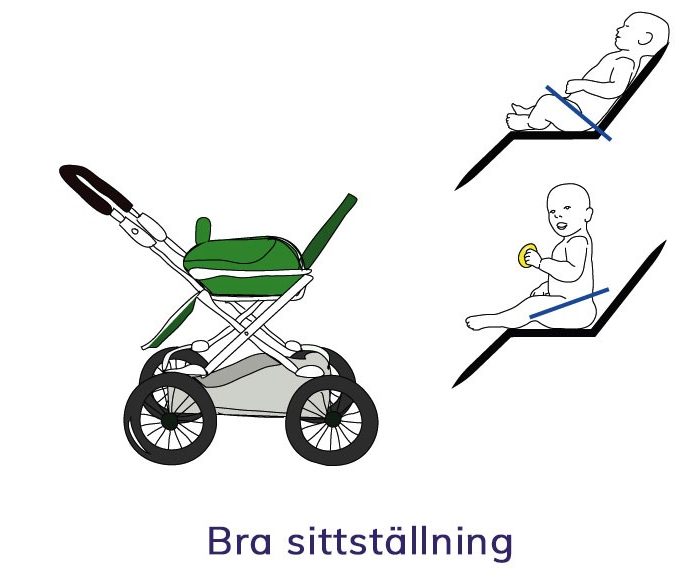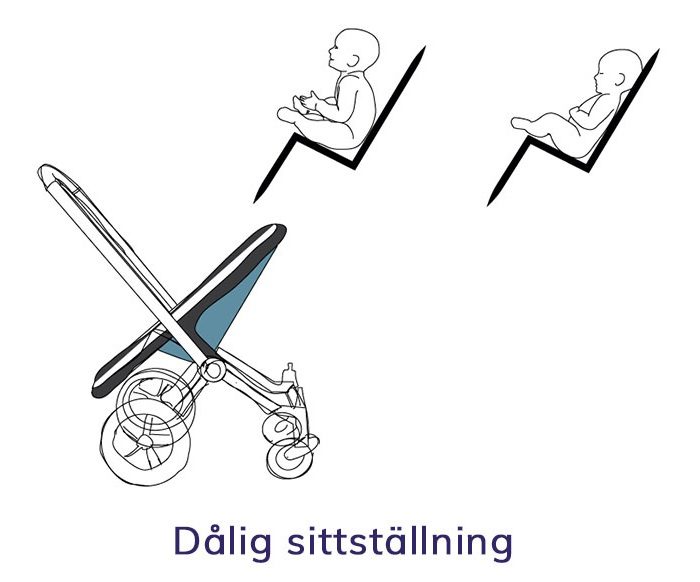Confusion in the definition of an “ergonomic” stroller
For all parents looking to buy a stroller, it’s important to consider factors that are important for both you and your child. Unfortunately, it’s common for non-ergonomic strollers to be marketed as ergonomic, creating confusion for consumers. Here’s some information about the seating position in “sitting strollers” – that is, how well the child sits.
Sitting is defined as an active upright sitting position where the child has a flat seat with the buttocks and legs as support surface and where the torso and head balance in a straight upright position above the support surface. When the seat leans backwards, the whole body becomes part of the support surface – it’s a resting position without strength and balance.”
The timing of when a child starts sitting varies, as it is related to the child’s motor skills. A child who, while lying on their stomach on the floor, begins to move around in place, not crawling but shifting in a circle, and rolling from back to stomach, generally has the strength to sit in a stroller without having full balance in a seated position. To achieve full balance while sitting, the child needs to practice sitting, and the stroller can assist with this. Even if the child sits still, the stroller moves, allowing the child to develop balance reactions to become even more stable.
A flat seating surface promotes good posture and alternates between activity and rest
In the stroller, the child should alternate between sitting upright with good posture and lying down to rest when tired. När barnet sitter rak behövs inget ryggstöd, ibland behövs ett bälte i lår-bäcken vinkeln för att ge stabilitet. Barnets motoriska förmåga och vagnens utformning påverkar barnets sittställning. The key to sitting upright with good posture is that the stroller has a flat seating surface. This allows for a proper pelvic position, which in turn creates a straight back. The back is straight when viewed from the front or back. When viewed from the side, it has a curvature, a lumbar lordosis, a curvature in the opposite direction in the thoracic spine, and a cervical lordosis. This is a natural curvature. However, sitting with a rounded “C-shape” or “poor posture” results in weakness—similar to bending a stick or pen, the rounded part becomes weak. With a rounded back, discs are compressed, and ligaments in the back are stretched. Adults experience back pain from sitting this way. The determining factor for sitting upright is the position of the pelvis. A posteriorly tilted pelvis results in a C-shaped back, and one sits as if doing a sit-up on an incline. A neutral or anteriorly tilted pelvis results in a straight back with normal curvature. One stays upright with muscles in the neck and back, which are the natural postural muscles. The feet should either have a flat support surface or, as the child gets older, the footrest can be folded down. Folding up the footrest in a seated position affects the pelvic position, causing it to tilt backward, and the back becomes “rounded.” The same thing happens with a so-called “hammock seat.” Even there, the pelvis tilts backward, and the back becomes rounded. En vanlig plan sits är bäst för barnets sittställning.A flat seat is best for the child’s sitting position.”
Resting position and footrest
When the child wants to rest, it wants to change position and open up the angle between the thighs and the back. Just like adults, it wants to straighten up when resting. Therefore, it is advantageous if a stroller can have a flat seat where the backrest can be reclined to various angles without affecting the seat. When sitting, the feet can either be straight ahead on a flat seat or hang down if you lower the footrest as the child gets older. Some seats tilt the child in a single position, either forward or backward. Then the child cannot change position naturally, and when sleeping, the feet are up in the air. This is unnatural for all of us and is not necessary.


Here you can download pictures of ergonomic and non-ergonomic strollers.
Ergonomic stroller
Non-ergonomic stroller